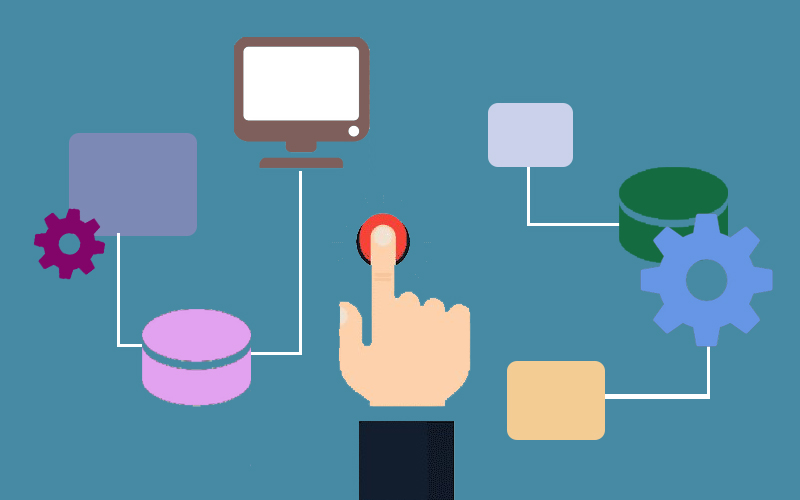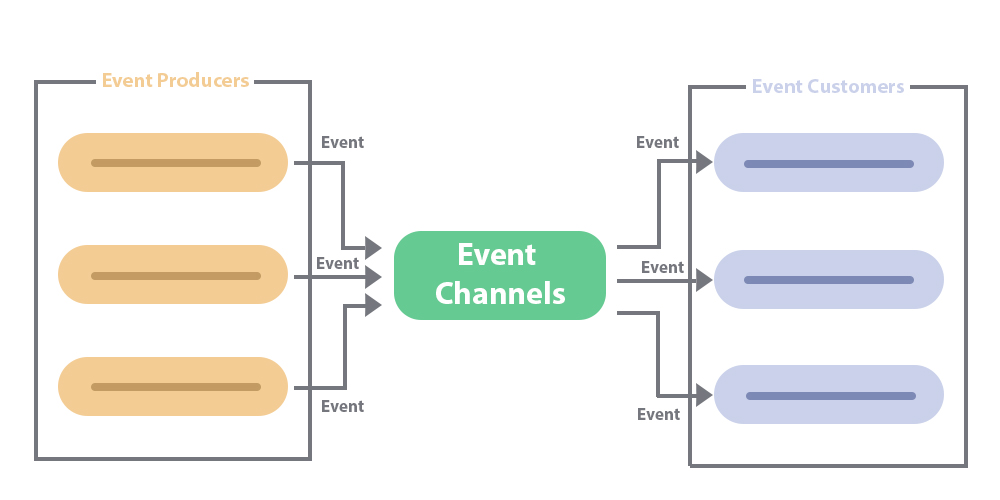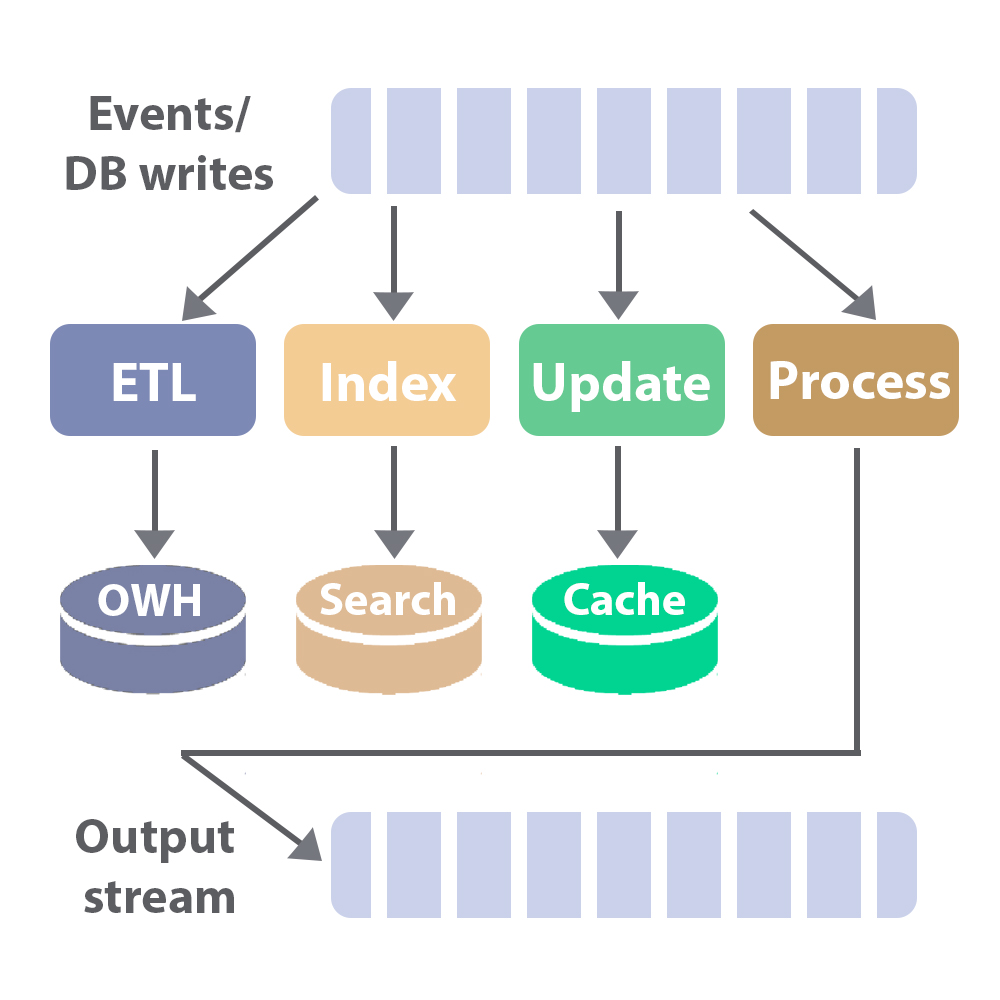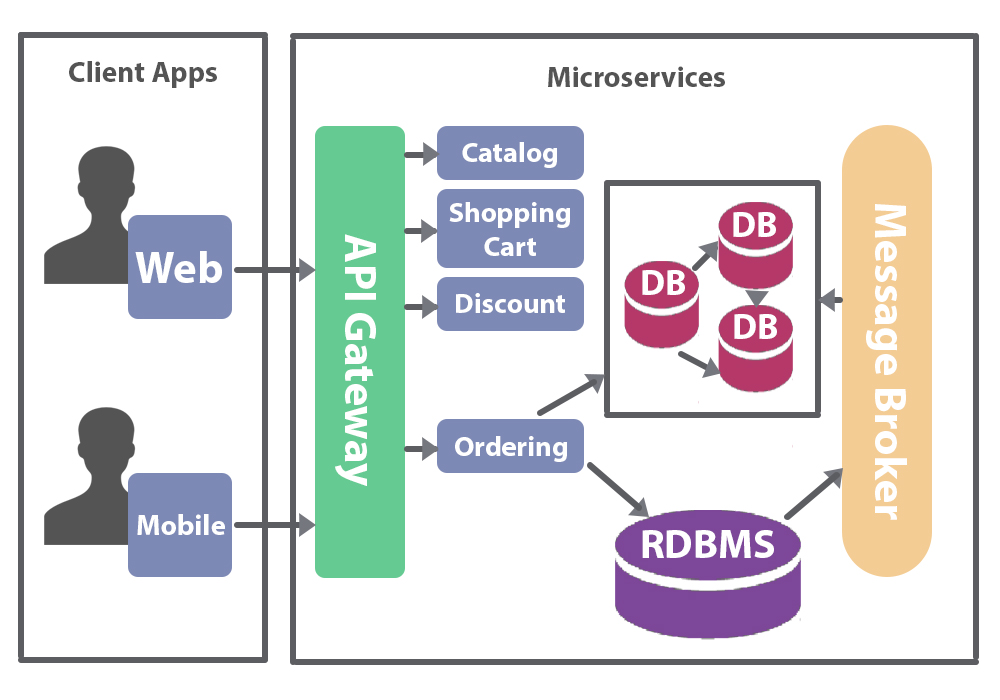

Event-Driven Microservices: Revolutionizing Scalability and Flexibility
Imagine a busy city where people are always talking to each other, sharing information, and reacting to what’s going on. Each person represents a microservice, and the events are the changes happening in the system. Imagine these interactions happening at lightning speed in real time while maintaining order and resilience. It is the world of event-driven microservices.
Event-driven microservices unlock a new level of communication and flexibility in software development. This architectural style allows developers to build robust, scalable, and adaptable applications by breaking them down into smaller, independent components that communicate through events. Keep on reading if you want to have a thorough understanding of this powerful approach and be ready to tackle the challenges of modern software development with event-driven microservices in your toolkit.
By combining the ideas of microservices and event-driven architecture (EDA), this architectural style makes it easier and faster for businesses to meet changing business needs. Today, we’ll talk about the advantages, ideas, design patterns, and real-world uses of event-driven microservices.
Defining Microservices
The microservices method is a software development approach that structures applications as a group of small, autonomous services. Each service is responsible for a specific business capability and can be developed, deployed, and scaled independently. Key benefits of microservices include:
- Improved scalability
- Enhanced flexibility
- Faster development cycles
Understanding Event-Driven Architecture in Microservices
Event-driven architectures (EDA) are software systems built around event production, consumption, and processing. Events are records of changes in state, such as a new order being placed or an item being shipped. EDA allows for the following:
- Real-time processing
- Decoupled components
- Increased resiliency
The Power of Combining Microservices and Event-Driven Design
By combining the principles of microservices and EDA, event-driven microservices offer a powerful approach for developing applications that are:
- Scalable
- Flexible
- Resilient
- Capable of real-time data processing
Let’s dive deeper into the world of event-driven microservices, discussing key concepts, patterns, and real-world use cases.
The Evolution of Software Architecture
The software industry has evolved from monolithic applications to microservices and event-driven architectures to meet growing scalability, flexibility, and real-time data processing demands.
Monolithic Applications
Traditionally, developers were building software applications as large, monolithic systems. These applications took a lot of work to scale and adapt to changing business requirements, leading to a need for more flexible and modular architectures.
The Rise of Microservices
As modern software applications continued to grow in complexity, it became increasingly clear that the traditional monolithic architecture was no longer sufficient. In response, a new approach known as microservices emerged, offering a solution to the limitations of monolithic applications.
By breaking applications down into smaller, autonomous services, developers gained the ability to update and scale individual components with ease. This increased flexibility and agility enabled them to respond more quickly to changing business needs, leading to faster innovation and greater competitive advantage.
The Need for Event-Driven Architectures
In today’s fast-paced world, the demand for real-time data processing has reached unprecedented levels, fueled by the explosive growth of modern applications. As a result, traditional monolithic architectures have become increasingly inadequate, unable to keep up with the speed and complexity of modern software systems.
Enter event-driven architectures – a dynamic and innovative approach that leverages asynchronous communication and component decoupling to provide unmatched flexibility and resiliency in software systems. By breaking applications down into smaller, autonomous services, event-driven architectures allow developers to process and respond to data in real time, improving scalability and fault tolerance while minimizing resource consumption.
The benefits of event-driven architectures are many, including lightning-fast response times, improved system reliability, and enhanced overall performance. These advantages make event-driven architectures the go-to choice for businesses looking to build software applications that can keep up with the ever-increasing demands of the market.
Key Concepts of Event-Driven Microservices
To understand event-driven microservices, we need to grasp the following key concepts:
- Events
- Event Producers
- Event Consumers
- Event Streams
- Event Aggregators

Events
An event is a record of a state change within a system. In the context of event-driven microservices, events are messages describing a specific action or occurrence, such as a user logging in or placing an order.
Event Producers
Event producers are components within a system that generate events. These can include user interfaces, devices, or other services. In a microservices architecture, each service can act as an event producer.
Event Consumers
Event consumers are components that listen for and process events. They react to events produced by other services, performing tasks such as updating databases, sending notifications, or triggering additional events.
Event Streams
An event stream is a sequence of events ordered by their production time. Event streams can be persisted for later processing or used in real-time to drive application behavior. In an event-driven microservices architecture, event streams enable communication between services and act as a source of truth for the system state.

Event Aggregators
Event aggregators power the event-driven microservices architecture. These advanced tools collect, filter, and disseminate events to the right consumers, ensuring seamless system flow.
Event aggregators regulate data flow, facilitate communication between components, and deliver events to the correct consumers at the right time by serving as a single hub for event processing. An event-driven microservices architecture without event aggregators would quickly become chaotic, with data flowing indiscriminately and critical events missed.
In short, event aggregators provide the critical infrastructure needed to ensure that applications run smoothly, efficiently, and reliably.
Benefits of Event-Driven Microservices
Event-driven microservices offer a range of benefits that stem from the combination of microservices and event-driven architecture principles. These benefits include such factors as:
Scalability: The ability to independently scale individual services helps to ensure that the entire application can adapt to changes in workload.
Flexibility: By decoupling services, event-driven microservices allow for easier updates and adjustments to individual components, making the overall system more adaptable to changing business requirements.
Resilience: The decoupled nature of event-driven microservices means that failures in one part of the system are less likely to impact other components, increasing overall system stability.
Real-Time Data Processing: Event-driven microservices enable real-time processing of events as they are generated, allowing for faster and more responsive applications.
Decoupled Architecture: The separation of concerns in an event-driven microservices architecture leads to more maintainable and modular code, making it easier to understand and modify.
The Power of Flexibility: How Event-Driven Microservices Transform Business Operations
In the constantly evolving business landscape, the need for flexibility and adaptability is more crucial than ever. The implementation of event-driven microservices has proven effective in facilitating this much-needed adaptability. Let’s explore how this approach has revolutionized the way businesses operate without diving into technical jargon.
Adapting to Change: Embracing the Unpredictable
The ability to adapt to change is vital for businesses that want to stay ahead of the competition. Unexpected market shifts, new technologies, and consumer trends can drastically alter the playing field. Event-driven microservices provide businesses with a way to respond to these changes more quickly and efficiently. This agile approach allows companies to reconfigure their operations in response to new events or changing conditions, ensuring they remain nimble and competitive.
Streamlining Communication: Breaking Down Silos
In many organizations, departments, and teams operate in isolation, leading to a lack of effective communication and collaboration. It can result in disjointed decision-making and inefficiencies. Event-driven microservices help to break down these silos by facilitating communication between different parts of the organization. This improved communication leads to better collaboration, faster decision-making, and ultimately more successful outcomes.
Scalability: Growing with Your Business
As businesses grow, they often face challenges in scaling their operations to meet increased demand. The addition of new team members, customers, and processes can put a strain on existing systems and infrastructure. Event-driven microservices allow businesses to scale more efficiently by enabling them to add or modify components without impacting the entire system. This flexibility helps organizations grow smoothly, minimizing growing pains and ensuring a seamless transition as they expand.
The Power of Real-Time: Making Data-Driven Decisions
In today’s fast-paced world, businesses need access to real-time data to make informed decisions. Traditional systems often struggle to process and analyze data in real time, resulting in delays and missed opportunities. Event-driven microservices can facilitate real-time data processing and analysis, enabling businesses to respond quickly to new information and make smarter decisions. The implementation of this technology leads to increased efficiency, better customer experiences, and improved performance overall.
Reducing Complexity: Simplifying Complex Processes
Managing complex business processes can be a challenging task for organizations. The need to coordinate various tasks, teams, and resources often leads to confusion, delays, and inefficiencies. Event-driven microservices can help simplify and streamline these processes by breaking them down into smaller, more manageable components. This approach allows businesses to tackle each component separately, making it easier to manage, monitor, and optimize their operations.
By embracing the power of event-driven microservices, businesses can adapt to changes quickly and seize new opportunities, ensuring they remain competitive and successful in the ever-changing landscape of the modern business world.
Popular Messaging Systems for Event-Driven Microservices
Various messaging systems can be used to facilitate communication between services in an event-driven microservices architecture. Some popular messaging systems include:
Apache Kafka: A distributed streaming platform designed for high-throughput, fault-tolerant, and scalable event streaming.
RabbitMQ: A robust and widely-used message broker that supports multiple messaging protocols and provides reliable message delivery.
Amazon Kinesis: A managed streaming service from AWS that enables real-time processing of streaming data at scale.
Google Cloud Pub/Sub: A messaging service from Google Cloud Platform that provides at-least-once delivery of messages and supports both push and pull-based message consumption.
NATS: A lightweight, high-performance messaging system that offers simple publish/subscribe and request/response patterns for event-driven communication.
Popular Messaging Systems for Event-Driven Microservices
Various messaging systems can be used to facilitate communication between services in an event-driven microservices architecture. Some popular messaging systems include:
Apache Kafka: A distributed streaming platform designed for high-throughput, fault-tolerant, and scalable event streaming.
RabbitMQ: A robust and widely-used message broker that supports multiple messaging protocols and provides reliable message delivery.
Amazon Kinesis: A managed streaming service from AWS that enables real-time processing of streaming data at scale.
Google Cloud Pub/Sub: A messaging service from Google Cloud Platform that provides at-least-once delivery of messages and supports both push and pull-based message consumption.
NATS: A lightweight, high-performance messaging system that offers simple publish/subscribe and request/response patterns for event-driven communication.
Design Patterns for Event-Driven Microservices
Several design patterns can be used to build robust and efficient event-driven microservices. These patterns include:
Event Sourcing
Unlike traditional data storage methods that rely on a single source of truth, event sourcing derives the state of an application from a sequence of events.
This approach has a number of key benefits, including greater traceability, auditing, and the ability to rebuild the system state at any point in time. By capturing every change that occurs in the system as a separate event, event sourcing allows developers to track and analyze the evolution of data over time, providing valuable insights into the behavior of the system and enabling more informed decision-making.
In addition, event sourcing enhances the resilience and fault tolerance of applications by allowing them to recover quickly and easily from errors or failures. By simply replaying the sequence of events that led up to a particular point in time, developers can recreate the system state exactly as it was, making it possible to address issues quickly and effectively.
Command Query Responsibility Segregation (CQRS)
CQRS is a pattern that separates the “read” and “write” operations of a system. This separation allows for independent scaling and optimization of each operation, improving overall system performance.

Saga Pattern
The saga pattern is used to manage distributed transactions in a microservices architecture. It involves breaking a transaction into a series of smaller, isolated steps, each of which is coordinated by an orchestrator service. This pattern helps to ensure data consistency across services while maintaining the benefits of a decoupled architecture.
Materialized Views
Materialized views are precomputed views of data that are updated when the underlying data changes. They can be used in event-driven microservices to create projections of data that are tailored to specific use cases, improving query performance and reducing the load on primary data stores.
Implementing Event-Driven Microservices
To successfully implement event-driven microservices, you can follow these steps:
1. Identify Domain Events
Domain events are the events that represent meaningful changes within your application’s domain. Start by identifying the key domain events that your system should handle and define their structure.
2. Define Event Contracts
Event contracts are the agreed-upon format and schema for events within your system. Establishing event contracts helps ensure consistency across services and makes it easier to evolve the system over time.
3. Design Event Consumers and Producers
With domain events and contracts defined, design the event consumers and producers for each microservice. Consider factors such as scalability, performance, and fault tolerance when designing these components.
4. Handle Data Consistency
One of the challenges in event-driven microservices is ensuring data consistency across services. Utilize patterns such as the Saga pattern or CQRS to manage distributed transactions and maintain data consistency.
5. Monitoring and Logging
Monitoring and logging are crucial for understanding the health and performance of your event-driven microservices. Implement logging and monitoring solutions to track events, detect issues, and analyze system performance.
Testing Event-Driven Microservices
Thorough testing is essential for building reliable and robust event-driven microservices. Key testing strategies include:
1. Unit Testing
Unit testing involves testing individual components or functions within your services. Ensure that all core functionality is covered by unit tests to verify correct behavior and catch potential issues early in the development process.
2. Integration Testing
Integration testing verifies the correct interaction between services and their dependencies, such as messaging systems or databases. Test the behavior of your services as they consume and produce events to ensure proper communication and data handling.
3. End-to-End Testing
End-to-end testing validates the entire system by simulating real-world usage scenarios. This type of testing helps to uncover issues that may not be apparent during unit or integration testing, such as problems with data consistency or event order.
4. Load and Stress Testing
Load and stress testing involves subjecting your system to high levels of traffic or workload to ensure that it remains stable and performs well under pressure. This testing is especially important for event-driven microservices, which often need to handle large volumes of events and real-time data processing.
Deployment and Infrastructure Considerations
When deploying event-driven microservices, consider the following aspects of infrastructure and deployment:
Containerization and Orchestration
Leveraging containerization and orchestration tools, like Docker and Kubernetes, streamline the deployment, scalability, and administration of microservices in a proficient and technical manner.
CI/CD Pipelines
The implementation of continuous integration and continuous deployment (CI/CD) workflows streamlines the automation of building, testing, and deploying microservices. Implementing CI/CD pipelines ensures that your services are always up to date and reduces the risk of deployment-related issues.
Security and Compliance
Ensure that your event-driven microservices adhere to security best practices and comply with relevant regulations. This may include securing communication between services, implementing access controls, and monitoring for potential security threats.
Observability and Monitoring
Implement observability and monitoring solutions to gain insight into the health and performance of your event-driven microservices. This can include monitoring event streams, tracking system metrics, and implementing distributed tracing to understand the flow of events through your system.
Challenges and Trade-offs
While event-driven microservices offer many benefits, they also come with some challenges and trade-offs:
Increased Complexity
Event-driven microservices can introduce additional complexity due to the asynchronous nature of event processing and the need to manage distributed transactions. Developers must carefully design and implement their services to handle these complexities effectively.
Eventual Consistency
Event-driven microservices often rely on eventual consistency, meaning the system state may be temporarily inconsistent during event processing. While this can improve performance and scalability, it may also require additional logic to handle temporary inconsistencies within the system.
Debugging and Troubleshooting
Debugging and troubleshooting can be more challenging in event-driven microservices due to the distributed nature of the system and the potential for events to be processed out of order or delayed. Implementing robust monitoring, logging, and tracing solutions can help mitigate these challenges.
Real-World Applications of Event-Driven Microservices
Event-driven microservices are used in a wide range of industries and applications, including:
E-Commerce
In the fast-paced world of e-commerce, where customer satisfaction is key, event-driven microservices have emerged as a game-changer. With their impressive capacity to handle large volumes of data and process requests in real-time, event-driven microservices enable businesses to deliver fast and reliable service that meets the expectations of today’s tech-savvy customers.
The days of frustrating delays and system downtimes that led to lost sales and dissatisfied customers are gone. With event-driven microservices, businesses can seamlessly handle complex tasks, such as processing orders and checking inventory, without breaking a sweat. This level of agility and responsiveness is crucial in the highly competitive e-commerce landscape, where customers expect nothing less than lightning-fast performance and impeccable service.
In addition, event-driven microservices can help e-commerce businesses personalize the customer experience. By tracking customer behavior and preferences, microservices can trigger events and messages that deliver personalized recommendations, promotions, and content to customers in real time. This not only improves customer satisfaction but also helps businesses drive sales and increase customer loyalty.
Another advantage of event-driven microservices is their ability to integrate with third-party services and APIs. This allows e-commerce businesses to easily connect with external partners and providers, such as payment gateways, shipping providers, and social media platforms, to provide a seamless end-to-end experience for customers. Microservices can also be used to monitor and analyze customer data, enabling businesses to make data-driven decisions and optimize their operations.
Finance
Financial institutions deal with massive amounts of data daily, including market data, customer information, and transaction records. With event-driven microservices, businesses can process and respond to this data quickly and efficiently, which allows them to make informed decisions in real time.
Event-driven microservices allow organizations to connect with other financial institutions, trading platforms, and regulatory bodies. Microservices can be used to process and transmit data between these systems, making it easier for businesses to comply with regulations, execute trades, and manage risk.
Event-driven microservices can also be used to enhance the customer experience in finance. For example, microservices can be used to trigger personalized messages and alerts to customers based on their behavior or transaction history. This can improve customer satisfaction and help businesses build stronger relationships with their clients.
Finally, event-driven microservices can be used to automate and streamline internal processes in finance. This includes tasks such as account management, fraud detection, and transaction processing. By automating these processes, businesses can reduce the risk of errors and free up their employees to focus on more complex tasks.
The Internet of Things (IoT)
IoT has revolutionized the way we live and work, connecting devices and sensors to the internet and enabling new levels of automation and efficiency. IoT devices generate massive amounts of data every second, including sensor readings, location data, and user behavior. With event-driven microservices, businesses can process and respond to this data quickly and efficiently, which allows them to make informed decisions in real time.
Event-driven microservices can also be used to enhance the functionality and intelligence of IoT devices. For example, microservices can be used to trigger events based on certain conditions or user interactions, enabling devices to respond in real time to changing environments. This can improve the efficiency of IoT systems and enable new levels of automation and control.
Finally, event-driven microservices can be used to improve the security and reliability of IoT systems. Microservices can be used to monitor device activity and detect anomalies or suspicious behavior. This can help identify and mitigate security threats before they cause harm.
Social Media
Social media has become an integral part of our daily lives, connecting us with friends, family, and the world around us. To keep up with the demands of users and stay competitive, social media platforms have turned to event-driven microservices to power their notification systems, content recommendations, and user activity tracking.
One of the advantages of event-driven microservices is their ability to personalize content recommendations for users. By tracking user behavior and preferences, microservices can trigger events and messages that deliver personalized recommendations and content to users.
Event-driven microservices can also be used to track user activity on social media platforms. It includes tracking user behavior, such as liking, sharing, and commenting on posts, as well as monitoring user-generated content for inappropriate or harmful content. By using microservices to automate these tasks, social media platforms can improve their moderation and content management capabilities.
Microservices can be used to power notification systems on social media platforms. It includes notifications for new followers, likes, comments, and messages. Microservices can be used to trigger events based on user activity, enabling social media platforms to deliver notifications to users.
Conclusion
Event-driven microservices offer a powerful approach to building scalable, flexible, and resilient software applications. By combining the principles of microservices and event-driven architecture, this architectural style enables organizations to adapt rapidly to changing business requirements while ensuring high performance and reliability. As a result, event-driven microservices are becoming an increasingly popular choice for modern software development.
